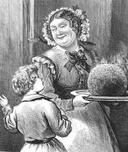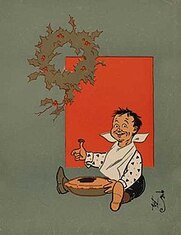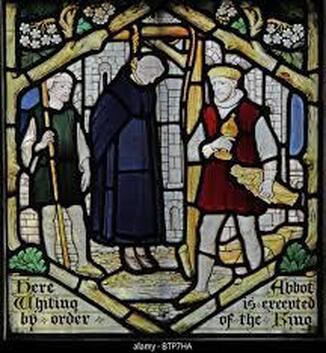 A couple of weeks ago I wrote a blog about wasailling and figgy pudding and I mentioned that the word plum didn’t necessarily mean a purple tree fruit. It's time to elaborate on that! You probably know the old nursery rhyme about Jack Horner, a boy eating his Christmas pie. If you don't, here it is:  William Wallace Denslow’s illustration of the rhyme, 1902 William Wallace Denslow’s illustration of the rhyme, 1902 Little Jack Horner Sat in the corner, Eating his Christmas pie; He put in his thumb, And pulled out a plum, And said, "What a good boy am I!" Recognize the style of the illustration? Denslow illustrated the Wizard of Oz books! The nursery rhyme is a fun little ditty, but it may have more behind it than you'd think. Webster's Dictionary says that, in addition to being the fruit of the prunus tree, a plum can be defined as something superior or very desirable, especially : something desirable given in return for a favor, and that may be what the nursery rhyme is really about. No one knows just how old this nursery rhyme is. It was first published in Mother Goose's melody, or, Sonnets for the cradle, which may have first been published in 1765, but is mentioned in a 1725 satire and may be much older than that.  In the 19th century, it was suggested that the poem is related to the period from 1536-1541, when the monastic system in England was being destroyed by Henry VIII after Parliament passed the Act of Supremacy, which made him the supreme head of the church in England, separating England from papal authority. Henry then expropriated the incomes of the monasteries and convents, increasing the regular income of the Crown. Much of the former monastic properties were sold off to fund Henry's military campaigns in the 1540s. By January 1539, Glastonbury Monastery was the last remaining religious property in Somerset that had not been dissolved. Glastonbury abbey was one of the richest and most influential in all England, with one hundred monks living in it. Many of the sons of the nobility and gentry were educated there before going on to university. The story is that Richard Whiting, the abbot, sent his steward, Thomas Horner, to London with a huge Christmas pie, into which he had placed the deeds to a dozen manors which the Monastery owned. The Abbot's hope was that by giving away such valuable lands, the King would allow the monastery to remain intact. During the journey Horner opened the pie and extracted the deeds of Mells Manor, which he kept for himself. While a manor would indeed be the something superior or very desirable, meant to be given to the Kind in return for the favor of the monastery's continued existence, there may be another wrinkle to the use of the word plum. Mells Manor, which is in the Mendip Hills, had several lead mines on it, and the word plum might be a pun on the Latin plumbum, or lead. Is this story true? While records exist that prove Thomas Horner became the owner of the manor, later owners assert that he didn't steal the deed, but purchased it from the abbey.  Regardless of whether Horner bought or stole the deed, the Christmas pie did not produce the intended result. On November 15, 1539, (aged 77 - 78, the king had the 78 year old abbot convicted of treason for remaining loyal to Rome. He was dragged to the top of Glastonbury Tor, where he was hanged, drawn and quartered. Whiting's head was hung over the west gate[ of his deserted abbey, and his limbs were displayed on the townwalls of Wells, Bath, Ilchester, and Bridgwater. Whiting was beatified by the Catholic Church in 1895. Jennifer Bohnhoff is the author of several works of historical fiction, none of which have a Christmas pie or plum pudding in them. You can read more about her and her books here. |





No comments:
Post a Comment